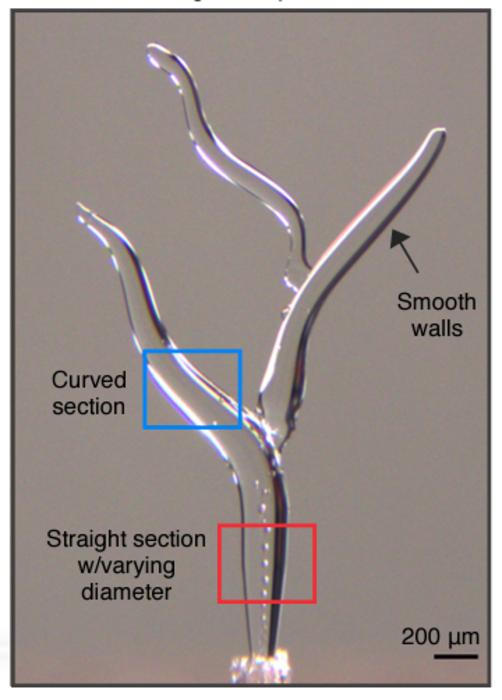Advances in 3D printing have enabled many applications across a variety of disciplines, including medicine, manufacturing, and energy. A range of different materials can be used to print both simple foundations and fine details, allowing for the creation of structures with tailored geometries.

Credit: Carnegie Mellon University College of Engineering
Advances in 3D printing have enabled many applications across a variety of disciplines, including medicine, manufacturing, and energy. A range of different materials can be used to print both simple foundations and fine details, allowing for the creation of structures with tailored geometries.
However, creating structures with micro-scale, precise internal voids and channels still poses challenges. Scaffolds used in tissue engineering, for example, must contain a three-dimensional complex network of conduits that mimic the human vasculature. With traditional additive manufacturing, where the material is deposited layer by layer, it’s difficult to print such intricate internal features without sacrificing time, accuracy, and resources.
To address this issue, Philip LeDuc and Burak Ozdoganlar, professors in mechanical engineering at Carnegie Mellon University, are spearheading the development of the freeform 3D ice printing (3D-ICE) process. This technique uses a drop-on-demand 3D printing approach with water as a substitute for conventional printing inks. A piezoelectric inkjet nozzle ejects tiny water droplets onto a build platform maintained below the freezing point. This causes the droplets to freeze shortly after contact.
Uniquely, the process can be controlled to deposit one or more droplets before the previous droplet is frozen. As such, a water cap remains atop the printed structure, and the freezing progresses from the bottom. This enables the creation of structures with smooth walls, transitions, and branches. Features as small as human hair can be fabricated. As more droplets are deposited, an ice structure takes shape on the build platform. The diameter, height, and relative smoothness of the pillar’s geometry can be adjusted by controlling the rate of droplet deposition, and the temperatures of the printing surface, droplet, and workspace. If the build platform is shifted such that the incoming droplet hits at an angle, the freeze front will rotate accordingly, making it possible to produce branching, curved, and overhanging structures that would be challenging or impossible to print with alternative 3D printing techniques without extra support materials.
“3D ice could be used as a sacrificial material, which means we could use it to create precisely-shaped channels inside of fabricated parts,” said LeDuc. “That would be useful in a lot of areas, from creating new tissues to soft robotics.”
Since the outset of their project, LeDuc and Ozdoganlar’s research team has investigated ways to ensure that the 3D ice process is predictable and reproducible. In their recent article published in the Proceedings of National Academies (PNAS, Garg et al., 2024), they describe 2D and 3D numerical models to elucidate the physics behind 3D ice, including heat transfer, fluid dynamics, and the rapid phase change from liquid to solid during the printing process.
Their 2D models map the construction of straight pillars, including the respective effects of layered and smooth deposition. “The frequency of droplet deposition affects the height and width of the structure,” said Ozdoganlar. “If you deposit quickly, the water cap grows, producing wider structures. If you deposit slowly, then the structure becomes narrower and taller. There are also effects from the substrate temperature. For the same droplet deposition rate, a lower substrate temperature produces taller structures.”
Their 3D models map the construction of oblique structures by predicting the rotation of the freeze front. “You have all types of heat transfer, including conduction to the bottom and convection to the surrounding area,” said Ozdoganlar. “All those things are working simultaneously when you deposit each droplet. If you deposit obliquely, part of the droplet spills over on the side of the pillar before it freezes. And as you keep depositing at that angle, the freeze front slowly changes shape, and the structure grows in that direction.”
In addition to further refining their mathematical models, LeDuc and Ozdoganlar’s labs are now looking to scale up 3D-ICE and explore its efficacy across a range of applications. For instance, current strategies in tissue engineering often involve designing generalized tissues. 3D-ICE could soon make it possible to print personalized tissues that match the unique structure of each patient’s vasculature, meeting the specific needs of the patient’s body. Moreover, 3D-ICE will enable the creation of functional tissue constructs for use in understanding different diseases or developing new therapeutics.
“When I first started my lab, I would never have imagined that we would be 3D printing ice, and using it to create tissues to help people,” said LeDuc. “But our research has evolved. It has brought people like Burak and myself together, and everyone brings all sorts of different perspectives and capabilities to the table. It’s a wonderful thing to do this work together where the sum of the parts is definitely greater than the individual parts in this transdisciplinary science and engineering.”
Journal
Proceedings of the National Academy of Sciences
Article Title
Physics of Microscale Freeform 3D Printing of Ice
Article Publication Date
15-Jul-2024



